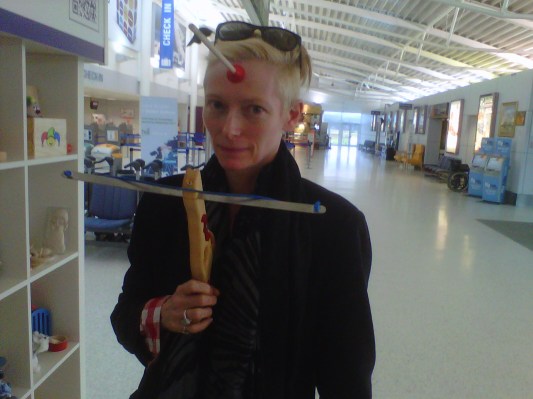
Tilda Swinton
If extraterrestrials sent Tilda Swinton to Scotland as an undercover emissary — and my profile of the actress in this week’s TIME (which can be found here) doesn’t rule out that possibility — they didn’t get her disguise quite right. Academy Award winner, muse to indie auteurs and fashion designers, Narnia’s white witch, Swinton has a spectral, almost alien beauty; at 51, she conspicuously lacks the gnarls and folds of the human aging process. I visited her in Nairn, the home town she calls “Brigadoon,” and stumbled in her wake on a hike through the gorgeous wilderness of heather-strewn ridges and mysterious valleys nearby, to discuss her storied career and the latest role predicted to garner an Oscar nod. In We Need to Talk about Kevin, Swinton plays Eva Khatchadourian, the conflicted mother of a teenager whose monstrous killing spree may partly reflect Eva’s own failings. The Academy often rewards actors for the gap between the role and their real-life selves and as Eva, the ethereal Swinton is messily, painfully human.
(PHOTOS: Model and Muse: Tilda Swinton on Being Photographed)
Film director Jim Jarmusch calls Swinton “an amazing creature.” The British actor Tim Roth describes her as a “mermaid.” She seems less real in the flesh than onscreen, not least because of an excess of perfection in the careless ease of her existence. In a wide-ranging conversation, she discusses a rich domestic life that includes her 14-year-old twins, their father, her “sweetheart,” the family’s five springer spaniels and a vegetable garden; her political views; and a passion for cinema that has informed her choices and underpins the 8 1/2 Foundation, her initiative dedicated to recommending and donating films to children.
The project was inspired by the Fellini film and by a question from Swinton’s son Xavier, when he was that age. What, he asked his mother, were people’s dreams like before the cinema was invented? This turns out to have been something of a preoccupation for earlier generations of the Swinton family too. Swinton ancestors include not only Robert the Bruce, but Alan Campbell-Swinton, whose pioneering work led directly to the invention of the television, and Ernest Dunlop Swinton, the inventor of the tank, who wrote science fiction under a pseudonym. One of his stories describes a visit to the early “cinematograph,” that goes horribly wrong.
His descendant has no such fear of silent movies. We Need to Talk about Kevin director Lynne Ramsay quotes her leading lady: “Film went downhill when words came in.” And Swinton is Buster Keaton as much as Lilian Gish. She’s been clowning since childhood, her survival strategy as the only girl among four siblings and as a bright child packed away to boarding schools that didn’t always appreciate her intellect or dissident views.
At Inverness airport — she insists on delivering me to my homeward plane — Swinton spots a toy crossbow for sale, complete with arrows tipped with suckers. Soon an arrow is planted in the middle of her forehead and she holds up the crossbow for a photograph. “I would say that’s a definite cover option, if not an alternative poster for [Kevin’s] worldwide release,” she emails later.

courtesy of Catherine Mayer

